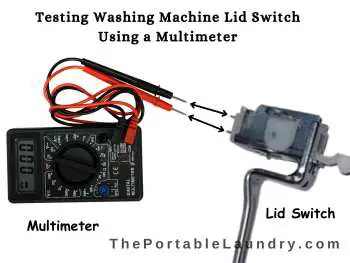In most cases, a lid switch is located at the top of the washer just under the washer’s top, on the lid, or near the top of the washer in front. Once you have located the lid switch you can replace it by using a putty knife and a screwdriver.
In order to replace the lid switch in a washing machine, use a putty knife to release the spring clip or locking tab that holds the lid switch in place. Next, unscrew the two screws that secure the lid switch and pull it out. Then install the new lid switch by simply reversing these steps.
The most challenging part of this entire process is removing the panels and then locating the lid switch, followed by detaching the wire harness for detachment.
But we will try to make it easier to get through this process with easy-to-follow step-by-step instructions.
Key Takeaways
- A lid switch offers an important safety feature in a washing machine. It won’t permit your washer to run if the lid is open, or if the lid switch is faulty.
- Always turn off the power supply to your washer and move it to a place where you can easily perform the repair work.
- Always test the lid switch first by using a multimeter before deciding to replace it.
- Read the user manual in order to locate the switch.
- Check if the washer is still under warranty as it may not make sense if it is and you can get it replaced for free.
- Consult a professional technician if you are having a hard time locating and replacing the switch.
Table Of Content
What is a lid switch in a washing machine?
The lid switch is a safety device that is usually located on the top of the washing machine. It prevents the washer from operating if the lid is left open for any reason.
A faulty switch will not allow your washer to run even if the lid is closed, thereby disrupting your laundry routine. In such a case, you will have to replace the switch in order to get your washing machine up and running again.
Depending on the model of the washer, there are various kinds of lid switches available. The most prevalent variety is the snap switch, which is found in most current devices.
They are simple to install or upgrade.
Another type of lid switch is the push-button switch, which is more complex to replace, but it’s doable.
If you have an older model, the lid switch type may be different. The toggle switch, rotary switch, and slide switches are some examples.
With all that said, just go through the user manual to determine which kind of lid switch your machine has so you can order the suitable one.
Why is the lid switch important?
The lid switch is extremely important from a safety standpoint. It is designed in such a way that it shuts off the power to the washer if the lid is open.
This helps to prevent injuries as well as water damage in case someone tries to operate the washer with the lid open.
In addition, the lid switch also helps to conserve energy by shutting off the power to the washing machine when the lid is open.
Where is the lid switch located in a washing machine?
The lid switch is usually located under the washer’s top, on the lid, at the top (front) of the washing machine, or below the control panel.
Moreover, in some washer models, the lid switch can be found hidden behind a small access panel.
If your washing machine does not have a lid switch, then it’s possible that it may have a door switch located in the doorjamb. It is usually a large, round, red-colored switch.
Both the lid switch and the door switch prevent the washing machine from operating when the lid or door is open.
Lastly, if your washing machine does not have a lid or a door switch, it may include an optical sensor.
The optical sensor is typically located in the doorjamb and uses a light beam to detect when the doorway is open.
If a lid switch turns out to be faulty or broken, then your washer will act weird. It will refuse to start when you close the lid. Furthermore, it may spin but won’t drain as required.
How can you tell if a lid switch is faulty or broken? (symptoms of bad washer lid switch)
One of the most common symptoms of a damaged or faulty lid switch is the “open door error code.” If the control panel on your washing machine indicates that the lid is not closed, it may be a sign that the lid switch is either faulty or worn out.
This is because the control panel uses sensors to detect whether or not the lid switch is engaged.
Other signs that you may need to replace the lid switch include the washer not starting, water filling issues, the washer not completing the cycles, and stopping mid-cycle.
While the above-mentioned symptoms are typical, in order to completely rule out the lid switch failure, you will need to test it.
How to test a washer’s lid switch?

Before deciding to replace the lid switch, it’s important that you test it to see if it’s truly faulty.
There is always a possibility that the problem is not with the lid switch but with something else entirely.
Testing the lid switch is fairly simple, you just need to see if there is a continuity between the two terminals when the switch is engaged.
Follow the below tips to test the washer’s lid
- Inspect for any dirt accumulation around the connected areas. If you find it dirty then simply clear the dirt accumulation using a soft-bristled brush and wipe it off with a damp cloth.
- Check the wiring to the lid switch to make sure it is not loose or if there are any signs of wear-outs. Make sure to inspect the connected wires thoroughly and the two connecting points.
- It is advisable to read your washing machine’s user manual before attempting to carry out any repairs or replacements as it will provide you with specific instructions that are related to the model that you are using.
- Use a multimeter to test the lid switch, to do this simply open the lid and press down on the switch. The multimeter should show continuity and if it does not then it may need to be replaced provided all the other electrical connections are in place.
Here’s how you can use the Multimeter
In order to test the lid switch, you will need a multimeter for the continuity tests.
Step 1: Start by detaching the lid switch from the main washing machine unit.
Step 2: To test the continuity, touch one end of the terminal with one probe and the other end of the terminal with the other probe.
Step 3: Next, actuate the switch and take the reading.
Step 4: If the meter reading shows some resistance, the switch is in good shape, and it indicates that the switch has continuity.
However, if the meter needle does not move or if the digital display does not show any changes, it means there is no continuity.
In other words, the switch is either damaged or worn out.
Note: If your washer uses a closed switch, the continuity should be there even before it’s activated. And if the washer is using an open switch, the continuity will show only post activating it. So, if the switch shows continuity when it’s not supposed to, it’s likely that the switch has been shorted.
How to replace the lid switch in a washing machine?
Follow the step-by-step instructions below to replace the faulty or damaged lid switch.
Instructions to replace the lid switch in a washing machine
A lid switch can be replaced within 30 minutes if done correctly.
Here’s how you can replace the lid switch at home.
Step 1: Disconnect the supplies
Unplug your washing machine from the power outlet and shut off the water supply.
In most cases, you may not need to move the washer from its place.
Step 2: Access the Lid Switch
To access the lid switch, you may have to disassemble the top panel of your washing machine.
So, remove the screws that secure the top panel of your washing machine to lift off the panel and place it aside.
For some washing machine models, you may have to remove the control panel first before detaching the top panel.
Next, remove the retaining screws from the control panel. In some models, you will find the retaining screws at the front, and in others, they may be located at the back.
If you aren’t able to locate the retaining screws, then they can be found hidden under plastic end caps.
Therefore, simply pull the end caps with your hands and unscrew them to remove the control panel.
If your washer’s control panel isn’t secured with screws, then it may be fixed using clips.
You may have to use a putty knife and insert it between the control panel and the holding panel of the cabinet.
Pluck it in the upwards direction so that the clips are released.
Note: For better access to the lid switch, simply refer to the user manual of your washer or you can contact the manufacturer’s helpline.
Step 3: Remove the wire harness
The lid switch will appear as a small device with a long wire heading toward a sensor or a PCB.
Remove the wire harness and snap out the spring clips using a flathead screwdriver.
Follow the connected wire and remove any grounded screws holding the harness or clips.
Then, gently unsnap the holding clips and keep them aside.
Step 4: Remove the lid switch
If the lid switch is held in place by two screws, remove them by unscrewing the screws or just prying it out of its component assembly (not applicable to all washers).
Step 5: Test the Lid Switch
Touch one terminal with a probe and the other terminal with another probe to actuate the switch.
If the meter reads show resistance, the switch is operating normally.
If the needle on the meter does not move or the digital display does not show any changes, there is no continuity.
Step 6: Install the Lid Switch
Once you have confirmed that the lid switch is problematic, it is time to replace it.
Install the new lid switch followed by reconnecting the wire harness and securing it with other clips as required.
Tip: While removing the wire harness, you can mark the wires, i.e., label them so that you don’t face any difficulty while installing the new lid switch.
Step 5: Reassemble the washer
Reassemble all the panels in the same order as you disassembled them.
Step 6: Run a test cycle
Plug your washing machine back into its power outlet and turn on the water supply valves.
Now, run a test cycle to make sure the lid switch is working as before.
Final Thoughts
A faulty lid switch can put your washing machine to a complete halt.
Replacing your washing machine lid switch is a very simple DIY fix that can be done using basic tools.
With that said, be sure to unplug your washing machine before beginning this repair, and always use caution when working with electrical appliances.
If you have any difficulties, pause yourself and contact a service professional for assistance.
Frequently Asked Questions
Are all washing machine lid switches the same?
Not all washing machines use a lid switch. Furthermore, slide switch types may differ depending on the make and model of your washer. You will need to check the user manual to find a suitable lid switch in case you intend to replace it.
What is the cost of a washing machine’s lid switch?
The cost of a lid switch depends on the model of your washing machine. With that said, you can expect to pay anywhere between $5 to $20 for a switch and if you include the labor cost, you can expect to pay anywhere between $80 to $200.
Why is my washer lid not locking?
If your washer lid is not locking, the problem could be with the lock and lid switch assembly. You will need to check if the switch itself is defective or if there is a problem with the locking mechanism.
You May Also Like
- How To Replace Dryer Heating Element? (Step-by-Step)
- How to replace the Igniter in a Gas Dryer?
- 14 Reasons Why Your Dryer is Squeaking & Solutions
- Washer Dryer: 27 Questions Answered
- How To Replace The Power Cord In A Washing Machine?
- How to replace agitator dogs in a washing machine?
- How to replace the timer switch in a Washing Machine?
- How to replace the tub seal in a top-load washing machine?
- How to replace the buzzer in a washing machine?
- How to Replace Washing Machine Capacitor? (Step-by-Step)
- How To Replace Tub-To-Pump Hose In Washing Machine?
- How To Replace The Drain Hose In Washing Machine?
- How To Replace Washing Machine PCB Board?
- How to Replace The Outer Panels Of A Washing Machine?
- How To Replace The Door Of Your Top Load Washer?





